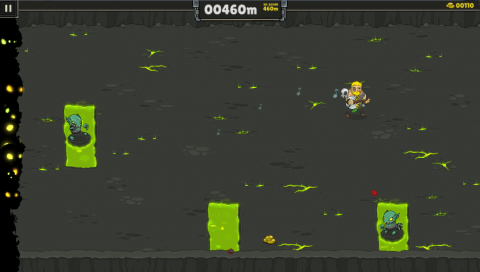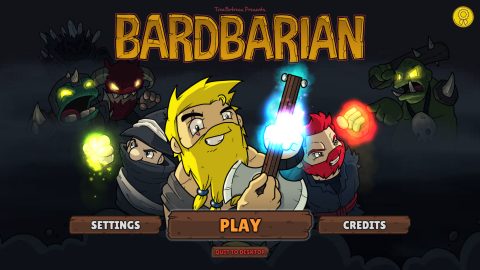
Most fantasy games have a strict formula they follow. This goes double for classes and jobs, as no character is ever allowed to do things outside their established class or sub-class. Mages stay in the back with magic spells, warriors soak damage, archers go for criticals from a distance, and so on and so forth. Canadian based TreeFortress Games decided to subvert this concept a bit, while also subverting the expectations of the RTS and tower defense genres. The end result was Bardbarian, a game about a barbarian warrior deciding to do the hero thing a bit differently.
The game’s story is simple. A barbarian wakes up one day, finds out that his town is under attack by monsters yet again, and he has to save them. However, smashing and slicing up evil has become a boring prospect to him. So, the barbarian becomes a bard by using some crafting skills to convert his battle ax into a musical ax, commanding brave warriors with the magical power of rock to defend the innocent and loot from the wicked.

The game proper plays out like a mixture of real-time strategy and tower defense, with a gem at the end of the town you must protect from attackers. You have to last out waves of enemies, with every fifth wave bring along a massive boss to fight, each completely different and significantly larger than any other enemy in the game. Enemies range from your basic goblins to beholders, skeletons that toss their own bones, and even suicide bombers, among other fantasy fare. Some are easy, some take a good bit of damage before going down. Most use projectiles, yet others will outright ram into your team.
The bardbarian isn’t a combatant, but rather a commander. You control only him, moving around, summoning troops, and playing songs that give buffs to attack, defense, and speed, along with a solo that stuns all enemies on screen after killing enough enemies without being damaged. Your team moves with you, while also auto-attacking at nearby enemies in their range. Some units also perform additional functions, like the engineers that create turrets while still, or necromancers that can turn downed enemies into zombies that explode on contact with the enemy. The Steam version also adds guest characters from Octodad, Shellrazer, a duo unit of Super Meat Boy and Isaac from The Binding of Isaac.

Like any good strategy game, every unit you can summon has its own uses and abilities. Outside support classes, like healers, you have offense classes that have a range to their attack. Short range units hits nearby enemies, medium range units attack from a distance, and long range units can snipe off damage from a safe distance. You’re only allowed three different units to summon, though a forth slot does exist. Thus, the goal is to figure out a good combination of units that have abilities that support each other.
The game gets hectic and fast, almost becoming like a shoot-em-up. Attacks are flying everywhere, and you’re constantly trying to dodge while also having to plan ahead to keep your party members out of line of fire and close enough to attack. However, attacks can miss, as constant movement makes it difficult for the team to aim their moves properly, so you also have to find times to stop. You also need to pay attention to your note count, which allows you to summon units and play stat buffing songs. This strange combo of genres results in a game closer to action than traditional strategy, and it works out all the better for it. It can be incredibly challenging as well, especially if you try out the extra modes to earn money.

This is a game where death is common to everyone but the most dedicated player. In order to progress, you need to buy upgrades at the shop for your units, the town, and yourself. The game’s sense of humor shines through here, as you have to pay the town residents for assistance, and you can even buy off the town drunk to vomit up gunk that slows down and even hurts enemies. The most useful power-ups, though, are easily body spray, which keeps the party closer together, and health upgrades.
This is also where the game becomes a grind. You constantly have to loot fallen enemies in order to make steady progress, and there’s a ton to purchase. It’s where the length comes from, as it’s very easy to spend over ten hours on the main twenty wave campaign. Those upgrades are vital, and they take a lot of time to earn. Thankfully, the gameplay is so solid that it remains a lot of fun to replay waves over and over, especially for the chance to experiment with party set-ups. As an experiment in genre based gameplay, Bardbarian is a success.

The game’s aesthetic style is not unlike an old Newgrounds Flash game with rough, comedic, and slightly ugly art and animation. Characters are like a collection of independent parts sown together, causing odd movements at times. It’s not the most graphically impressive game, but the art style is helps pushing the game’s silly mood. The game definitely looks better in motion than in still shots, though this may be simply because you’re constantly doing something and don’t have time to focus on details or flaws.
The game as a whole is a very odd duck. It’s heavily flawed in many ways, especially with performance issues on PC, but it’s wonderfully creative, and that’s something to respect. The fact that it plays well and offers a lot of creative strategy from the player is appreciated as well. It’s a good example of the qualities of the then growing indie mobile market; learning to work with limitations to deliver something familiar but inventive.
Links:
TreeFortress Games Official website for Bardbarian
Bardbarian Steam page



















